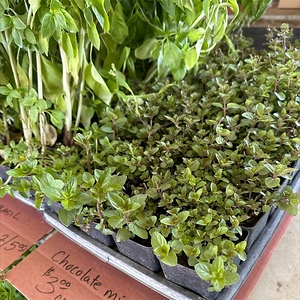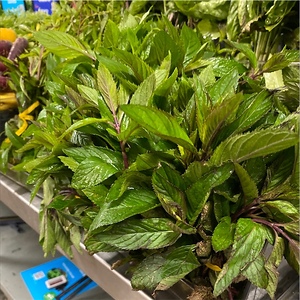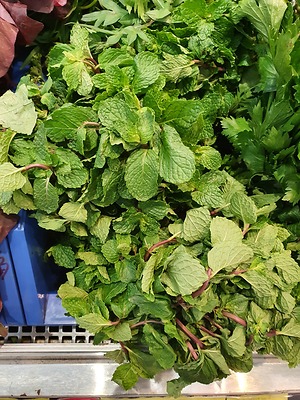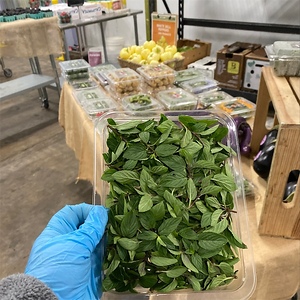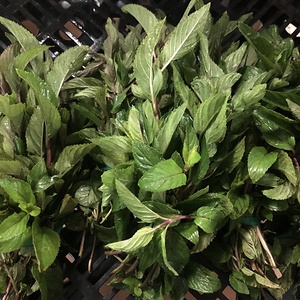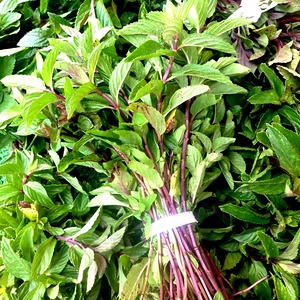


Chocolate Mint
Estimated Inventory, bunch : 0
Description/Taste
Chocolate mint is a fast-growing herb that reaches about 60 centimeters tall, easily spreads by underground stems as a ground cover, and produces small lavender flowers when mature. Its rounded, lance-shaped, dark-green leaves grow along square stems, characteristic of the mint plant family, and are darker in comparison to the bright-green leaves of other common mint varieties. The leaves have toothed edges with dark-purple to burgundy veins and undersides, matching the dark stems and giving them a colorful appearance that is often described as reminiscent of an after-dinner chocolate mint. Chocolate mint offers a cool peppermint fragrance and flavor with subtle, sweet notes of chocolate and vanilla that vary in vigor, from indiscernible to unmistakable.
Seasons/Availability
Chocolate mint is available year-round, with a peak season in the summer.
Current Facts
Chocolate mint is a member of the Lamiaceae, or mint family, and is botanically classified as Mentha x piperita f. citrata ‘Chocolate.’ As the botanical name suggests, Chocolate mint is a hybrid cultivar of peppermint, Mentha piperita, that is believed to have been formed by a cross with orange mint, Mentha citrata. However, its origin is surrounded by some confusion, and some experts believe that it was selected from a cross between watermint, Mentha aquatica, and spearmint, Mentha spicata, instead. Its biological history isn’t the only point of controversy for this particular plant. Some people detect chocolate notes strong enough to liken the taste to Andes mints or Thin Mint Girl Scout cookies. In contrast, others don’t believe Chocolate mint has any distinguishable nuance of chocolate or only acknowledge wafts of warm peppermint-chocolate tones in the aroma, but not the taste.
Nutritional Value
Like other mint varieties, Chocolate mint is rich in vitamins A and C and contains trace amounts of manganese and potassium. It is also known for its rosmarinic acid, an antioxidant that fights inflammation and hence may help relieve symptoms of allergies. Mint essential oils have long been used medicinally to combat nausea, cramping, and indigestion.
Applications
Chocolate mint is best used fresh and popular in sweet applications. Fresh chocolate mint leaves can be used to garnish or impart flavor in desserts like brownies, cakes, custards, mousse, milkshakes, or ice cream, as well as drinks like tea, hot chocolate, lemonade, mojitos, and mint juleps. They can also be used to infuse oil or cream or to make mint sugar by finely grinding the fresh leaves with sugar for use in baking. Try adding freshly chopped leaves to fruit salads or freezing them in ice cubes or popsicles. Dried Chocolate mint leaves can be used for tea or added to coffee grinds before brewing to impart a cocoa-minty kick. While Chocolate mint shines in sweet applications, it can also be used in savory dishes, such as lamb or fish. Chocolate mint leaves can be frozen or dried for future use. To dry, hang bundles of leaves upside down in a warm place away from direct sunlight. Fresh Chocolate mint leaves may be stored in the refrigerator for about four days.
Ethnic/Cultural Info
Chocolate mint was selected and cultivated for its unique blended flavor of chocolate and peppermint. It’s a favorited flavor pairing that has become so popular that the flavor profile has earned its own holiday in the United States. National Chocolate Mint Day is recognized annually on February 19th as a day to celebrate the unique combination of chocolate and mint, which has become a classic flavor pairing ever since the introduction of several iconic mass-manufactured mint chocolate confectionaries, from Andes chocolate mints of the early 1920s to the York Peppermint Patty of the 1940s, to the Thin Mint Girl Scout cookie of the early 1950s.
Geography/History
Like other mint varieties, Chocolate mint can trace its ancestry back to Europe, Africa, and Asia, though the exact origin of this particular hybrid is unclear. It thrives in various growing conditions and is one of the few culinary herbs that prefer partial shade, although it can still grow in full sunlight provided it has moist soil. It is easy to grow, and while this particular cultivar is not quite as rampant as other notoriously intrusive square-stemmed members of the mint family, it will still readily spread and take over as ground cover if it is not grown with an underground barrier or in a container. Because Chocolate mint is a sterile hybrid, it does not produce seeds but is rather grown from nursery starts or stem cuttings. Chocolate mint can be found at specialty stores and farmers markets.
Recipe Ideas
Recipes that include Chocolate Mint. One
| Tales From a Cottage |
|
Chocolate Mint Tea |
| Common Sense Homesteading |
|
Easy Chocolate Mint Extract |
Podcast







